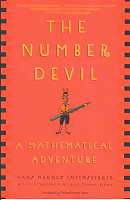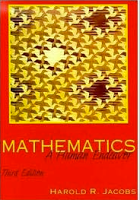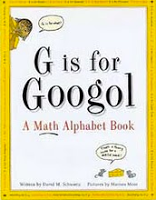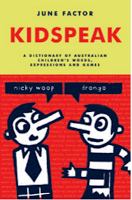David M. Schwartz's Blog, page 3
February 22, 2010
If They Had A Million Dollars
Remember the hit song by the Barenaked Ladies, a Canadian alternative rock band (whose members are neither ladies nor naked — it least in public)? Here's how it starts:
If I had a million dollar
If I had a million dollars
Well I'd buy you a house
I would buy you a house
I'd buy you furniture for your house…
Hate to sound like a million dollar spoilsport, but I sure wouldn't pay a million for those lyrics. Not even a hundred. Still, the tune is darn catchy, and the refrain is a bit touching:
If I had a million dollars,
I'd buy your love.
Whether or not that particular commodity can be purchased at any price will not be the subject of this post, although you may wish to pursue it elsewhere.
Since the 1989 publication of my second book, If You Made a Million, I have seen countless examples of student writing that begin with the prompt, "If I had a million dollars…" They fall into three categories of roughly equal size. I'll call the them "fulfillment," "greed" and "charity."
By "fulfillment" I mean the meeting of life's needs and reasonable desires to improve one's life. (OK, I admit I've made myself the sole judge of "reasonable" but I think you'll sign on with me.) Those children whose million dollar dreams fall in this category tend to be realistic. With a little financial boost, they could probably buy the things they're wishing for. And so we have six-year old Alexandra who writes in Alexandra's Million Dollar Book (with a dedication page, incidentally, honoring one David Schwartz):
If I had a million dollars I would ask my Mom, "Can I have a book?"
If I had a million dollars I would ask my Dad, "Can I have a pet?"
I would guess that Alexandra's life would be improved by the arrival of a pet and a book. If I could be the genie in the oil lamp, I would grant Alexandra her two modest wishes. Other children have wished for clothing, toys, trips, tickets to concerts or sporting events, their favorite foods, even — sadly —heat for their homes. Some of the cravings enter the realm of the luxurious — a swimming pool, for instance, in Opelika, Alabama. But considering the summertime heat and humidity of Alabama, I would say the swimming pool could help improve the yearner's life (or at least comfort).
Eventually we cross the fuzzy line that separates fulfillment from greed. Here we have children gunning not for just one toy but for thousands or millions of them — often duplicates of the same thing. "I would buy a million Nintendos" or "a million Wiis" or whatever happens to be the hot gizmo du jour. But that's only the beginning of million-dollar greed. I've seen kids spend their imaginary million on items that a billion dollars couldn't buy: "I'd buy Disney World." Not content with a such a meager piece of real estate, one spender revealed a vaster aspiration: "I'd buy Florida!" Even that was outdone by the child who boasted, "I would buy the World!"
But to me, the big winner here is philanthropy. I'm pleased to know that about a third of the authors spent their fictional money to improve the lives of others. Some took on lofty, if vague, goals like "I would buy food for the poor" while others were more specific: "I would buy a car for my brother so he can get to work." Or, "I would give my money to my nice teacher, Mrs. Swartzel, so she can buy a golden necklace, golden ring, a golden castle. I like my teacher." (Appropriately enough, this magnanimous student is named Buddy.) Some gave to organizations (a pie graph of "How I Spent my Million" showed sizeable slices of the pie served to worthy causes including the Leukemia Society and the Adopt a Giraffe Society). My all-time favorite came from a girl named Margarita: "I would shar my money with our teachers, the prin and the children." (I assume the letters "cipal" were meant to come after "prin.")
With a million in spending money, some combine greed with philanthropy. One standout example came from the writer who wanted to buy a big dinner for everyone in his school and then use any money left over to buy himself a horse, twelve dogs and a Ferrari.
Whether motivated by self-improvement, greed or philanthropy, this kind of imagining does motivate kids' writing, but I hope their written words are accompanied verbal discussions. If I were the teacher, I would have as many questions as the kids have ways to satisfy their spending lust. For starters: "Could you really buy a million computer games for a million dollars? And why would you want a million of them anyway?"
It might be worth pointing out that many items on the kids' wish lists, such as Disney World, would knock you back more than a million. And even with an unlimited budget, not everything in the world is for sale. The State of Florida would be on that list (though some political observers might disagree!).
Of course with a little guidance, these exercises can be mathematical as well as literary. Like something out of Math Curse, the math problems should flow like liquid dollars from the spending pumps of these students. Every time I read "If I had a million dollars, I would buy a million X," I wonder if anyone asked the child how much each X would cost if you could buy a million for a million dollars. If they cannot come to see the unit cost as $1, an important prospective math lesson has been missed.
One 4th grade class used a million-dollar spending spree as the basis of a subtraction activity in which each child was issued a checkbook with a balance of $1,000,000. Finding real prices of items advertised in magazines and newspapers (no houses allowed and no more than one car), they had to spend their way down to $0, showing the math each step of the way. The kids were surprised to see how long it took them to dump that much money.
If only it worked that way in real life.
January 29, 2010
Math-Lit for the Older Set
I got an email the other day from a parent looking for good mathematical literature to interest and challenge older children. Is there any? Which books would I recommend?
Before I describe a few of my faves, I must point out, as I did at length in my INK post of May 28, 2008, that many educators have inspired intermediate grade, middle school and even high school students with picture books, using them as age-appropriate teaching tools. I believe my most successful mathematical picture books are those that can be used on many levels. In fact, when asked the target age for How Much is a Million?, I often say, "Preschool through high school." Actually, it's not true. I should say. "Preschool through college," but that answer might sound overly smug. (I have twice met college professors who use my book when teaching about Avogadro's number, a behemoth number critically important in understanding quantitative chemistry.) That said, I will mention a few books that probably wouldn't make it into the 2nd grade math classroom but should be a staple of math classrooms or libraries serving upper elementary, middle school and high school students.
In The Number Devil by German author Hans Magnus Enzensberger, a middle school-age boy named Robert dreams of travels through the world of mathematics under the tutelage of an impish devil whom he at first finds annoying but gradually comes to enjoy and admire. At the start of the book, Robert is a mediocre and indifferent math student — no surprise, considering that his ho-hum teacher at school gives the students mathematical busywork without the least bit of mathematical inspiration. (His uncomprehending mother is no better: she believes a son who voluntarily speaks of mathematical concepts must be ill!) But Robert and the devil are on an irrepressible romp and together they challenge each other while developing plethora of mathematical concepts and meeting a pantheon of famous mathematicians. All names are whimsically disguised — Leonhard Euler becomes "Owl" (Eule in German translates to "owl" in English) and roots (as in square roots, cube roots, etc.) are called "rutabagas" (which are literal roots) — just two of many such examples. Figuring out the conventional words for the concepts at hand just adds to the devilish fun of this 1997 book which is well on its way to becoming a classic.
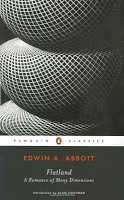 Flatland is not on its way to classic status: it's already there. Like The Number Devil, it incorporates dreams but the concepts are geometrical rather than numerical. This novella, written in 1884 by English schoolmaster Edwin A. Abbott, is a pointed satire of closed-minded, hierarchical Victorian society but it is also, as Isaac Asimov put it, "The best introduction one can find into the manner of perceiving dimensions." The story has been developed into several short films and a 2007 feature film; there have been TV episodes, a role-playing game and sequels by other authors.
Flatland is not on its way to classic status: it's already there. Like The Number Devil, it incorporates dreams but the concepts are geometrical rather than numerical. This novella, written in 1884 by English schoolmaster Edwin A. Abbott, is a pointed satire of closed-minded, hierarchical Victorian society but it is also, as Isaac Asimov put it, "The best introduction one can find into the manner of perceiving dimensions." The story has been developed into several short films and a 2007 feature film; there have been TV episodes, a role-playing game and sequels by other authors.
The narrator of the original Flatland is a square named – ready? — A. Square. He lives in a two-dimensional world, Flatland, but dreams of visiting a one-dimensional world, Lineland, where he tries to convince the ignorant monarch of a second dimension but fails to open the ruler's eyes to a universe beyond his familiar straight line domain. He also goes to one-dimensional Pointland inhabited by a monarch who is the sole inhabitant and, in fact, is the entire universe in and of himself! (He perceives any attempts at communication from the outside world to be his own thoughts.) Later, our narrator is visited be a three-dimensional sphere, which he finds incomprehensible until he accompanies Sphere to Spaceland. From there, the two discover that the leaders of Flatland know about Spaceland and a third dimension, but they prohibit their subjects from acknowledging it, under penalty of death or imprisonment. Square tries to convince Sphere of the possibility of fourth and fifth dimensions, but the notion is soundly rejected and Square is sent home in disgrace. It's not a happy story but fascinating and uplifting in its own way, and, like the subject matter, the book has many dimensions.
Mathematics: A Human Endeavor by Harold R. Jacobs is a wide-ranging mathematics textbook so deliciously fun and fascinating that kids actually want to read it. Even more astonishing, their parents and teachers can't put it down either. As a college senior, I discovered its first edition (it's now it its third) while volunteering as an enrichment provider to a select group of very sharp fifth graders, and I was hooked. Jacobs covers the breadth of high school mathematics with an emphasis on the beauty and power and real-life relevance of each subject. Aptly-chosen cartoons made me and my students laugh outloud, and we immediately saw that the cartoons weren't included just for the guffaws. "An improvement over the square wheel," pronounces B.C in the caption of one drawing as he flaunts his great invention: a triangular wheel. "It eliminates one bump!"Jacobs shows how B.C.'s thinking is dead wrong, and in so doing, he develops principles of polygons and the mathematical concept of limit: as the number of sides grows and approaches infinity, the polygon approaches a circle — the "wheel" with no bumps (road surface willing!).
In lucid prose, the subjects range from algebra and geometry to probability, topology, statistics and more. Jacobs often shows how the math being taught is found not only in books but in life. This book has become a staple among alternative high schools and homeschoolers, but I find it so readable that it doesn't have to be thought of as a textbook at all. Just the same, a teacher's guide is available.
A major step down from the literary giants I've just described is my own picture book targeted at upper-elementary and middle school age children. G Is for Googol: A Math Alphabet Book is a potpourri of topics from "A is for Abacus" (proficient abacus users outcompete calculator users every time) to "Z is for Zillion" (not actually number, which provides an excuse to talk about what makes a number a number). Math-loving kids of all ages have found respite in its pages, and math teachers sometimes read from it to provide literary snacks on special days. It has spawned many a student-created alphabet-book as class projects. A 6th grade class in Colorado called theirs An Algabet Anthology by "The Awesome Accelerated Academics." At first I thought the title had a typo but I later realized that "algabet" is just a play on "algebra." Sixth grade humor. The word play continues to the final page:
THE END
We Hope This Book
Arithmetickled You Pink
December 21, 2009
The Play's The Thing
The mother of a 7th grader in Oakland, CA, tells me that morning recess at her son's middle school has been cut from twenty minutes to ten, and the entire recess, formerly held outdoors, is now limited to an indoor space. Even the theoretical 10 minutes is often whittled down to just a few minutes or none at all because teachers respond to the disruptive in-class behavior of a few students by holding the class through recess to make up for classroom delays.
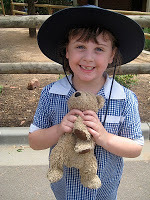
This sorry state of affairs is not limited to the United States. I am just back from speaking at primary (elementary) schools in Australia. I had a few opportunities to interact with children on the playground and I was pleased to notice the great variety of types of play, and how there seemed to be a niche for everyone. Some activities engaged solitary children, others occupied pairs or small groups, and a few involved large numbers. Yet when I shared my approving observations with teachers, I learned that, as in the U.S., recess is an endangered species.
Studies consistently prove its value. In one set of experiments from the mid-1990s, researchers found that school children became less and less attentive the longer recess was delayed. Another experimental study found that "fourth-graders were more on-task and less fidgety in the classroom on days when they had had recess, with hyperactive children among those who benefited the most." An article in the New York Times in February, 2009, cited a study of 11,000 third graders showing that recess mitigates children's behavioral problems. (Consider the common punishment for misbehaving children: "No recess!") And a meta-analysis of over 200 studies suggest that physical activity during the school day results in more, and better, mental activity.
For all their lip-service to the necessity of drawing on research-based teaching strategies, education authorities in the U.S. and Australia (and probably many other countries) don't seem to care much about research on play. It is interesting that, by contrast, China launched a nationwide "Sunlight Sport" campaign in 2007, requesting that every school offer one hour of sports and games daily to every student.
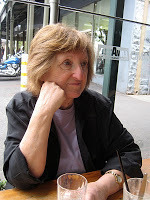
I read about Chinese children's play and the Sunshine Sport campaign in a fascinating Australian journal called Play and Folklore, co-edited by Dr. June Factor of the University of Melbourne, an author and folklorist who writes playful and play-filled books for both children and adults. I met June at a reading conference in California about 15 years ago, and I had the good fortune of visiting her in Australia during my recent trip.
The most wonderful thing about many of June's books for children is that they are actually by children: she is merely the compiler, and what she has compiled is straight from the mouths of kids, whom she and her university students have observed, recorded and interviewed in school playgrounds. The researchers collected children's games, rhymes, sayings, chants, riddles, jokes and secret languages in abundance. In 2000, she published an entertaining and enlightening lexicon, Kidspeak: A Dictionary of Australian Children's Words, Games and Sayings. The two children depicted on the cover have harsh words for each other: "Nicky woop" says one in a speech bubble, to which the other retorts, "Drongo!" (Translation: "Go away!" and "Jerk!")
June's collections for young readers have been loved since 1983 when Far Out, Brussels Sprout came out. It has since been joined by Real Keen, Baked Bean…Unreal, Banana Peel…Okey Dokey, Karaoke, and others in the Far Out! series. All offer a rich sampling of the linguistic range and complexity of Australian children's vernacular language. "It's children's own literature," says June, "handed down across many generations, sometimes across centuries. It's a bridge across generations, common to childhood, not just contemporary childhood." From Far Out, Brussels Sprout:
Quickly, quickly, I feel sickly.
Hasten, hasten, get the basin.
Ker plop!
Get the mop!
—————
Mary had a little lamb
She kept it in a closet.
And every time she let it out
It left a small deposit.
They're not always the most proper ditties in the world. As a result, a decade ago June learned that she was the second-most censored author in Australian school libraries, after Judy Blume. She told me this with more than a hint of irony, considering that the censors were trying to save innocent children from their own words. "It tells you much about the power of adult prudery and unease about the human body and its functions — but, I hasten to add, not nearly as much as in the United States!"
Often, these censorship cases have been dismissed when the schools discovered how many families already owned the challenged books. But what disturbs June more than censors in the libraries is timekeepers on the playgrounds. "Increasingly, playtime is being restricted," says Australia's leading observer of playtime. "It's happening in America and it's happening here." In the U.S., where we once feared a "red menace" from Asia, there now seems to be fear that Asian countries including China will overtake us not militarily but intellectually and economically. If it comes to pass, browbeating analysts should consider how our schools rejected the demonstrable benefits of playtime. American education authorities could have the demise of recess to blame for our fall from intellectual eminence. Some might call them drongos!

